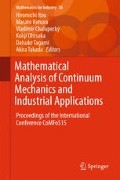Abstract
As an application of the phase field model for crack propagation in elastic body, chemical-diffuse crack growth model with the effect of the hydrogen embrittlement is considered. Numerical results show the difference of crack path between data with the effects and data without the effect. Temporal evolution of the normalized difference of phase field depict the time when start the difference of crack path.
Access this chapter
Tax calculation will be finalised at checkout
Purchases are for personal use only
References
Belytschko, T., Black, T.: Elastic crack growth in finite elements with minimal remeshing. Int. J. Numer. Methods Eng. 45, 602–620 (1999)
Takaishi, T., Kimura, M.: Phase field model for mode III crack growth. Kybernetika 45, 605–614 (2009)
Kimura, M., Takaishi, T.: A phase field approach to matehmatical modeling of crack propagation. A mathematical approach to research problems of science and technology mathematics for industry 5, 161–170 (2014)
Francfort, G.A., Marigo, J.-J.: Revisiting brittle fracture as an energy minimization problem. J. Mech. Phys. Solids 46, 1319–342 (1998)
Ambrosio, L., Tortorelli, V.M.: On the approximation of free discontinuity problems. Boll. Un. Mat. Ital. 7, 105–123 (1992)
Troiano, A.R.: The role of Hydrogen and other interstitials in the mechanical behaviour of metals. Trans. ASM 52, 54–80 (1960)
Beachem, C.D.: A new model for hydrogen-asisted cracking. Metall. Trans. 3, 437–451 (1972)
Griffith, A.A.: The phenomenon of rupture and flow in solids. Philos. Trans. Roy. Soc. Lond. A221, 163–198 (1921)
Bourdin, B.: Numerical implementation of the variational formulation of brittle fracture. Interfaces Free Bound. 9, 411–430 (2007)
Buliga, M.: Energy minimizing brittle crack propagation. J. Elast. 52, 201–238 (1998/99)
Kobayashi, R.: Modeling and numerical simulations of dendritic crystal growth. Physica D 63, 410–423 (1993)
Hecht, F.: New development in FreeFem++. J. Numer. Math. 20, 251–265 (2012)
Acknowledgments
This work is in collaboration with M.Kimura.
Author information
Authors and Affiliations
Corresponding author
Editor information
Editors and Affiliations
Rights and permissions
Copyright information
© 2017 Springer Nature Singapore Pte Ltd.
About this paper
Cite this paper
Takaishi, T. (2017). Phase Field Crack Growth Model with Hydrogen Embrittlement. In: Itou, H., Kimura, M., Chalupecký, V., Ohtsuka, K., Tagami, D., Takada, A. (eds) Mathematical Analysis of Continuum Mechanics and Industrial Applications. Mathematics for Industry, vol 26. Springer, Singapore. https://doi.org/10.1007/978-981-10-2633-1_3
Download citation
DOI: https://doi.org/10.1007/978-981-10-2633-1_3
Published:
Publisher Name: Springer, Singapore
Print ISBN: 978-981-10-2632-4
Online ISBN: 978-981-10-2633-1
eBook Packages: EngineeringEngineering (R0)

